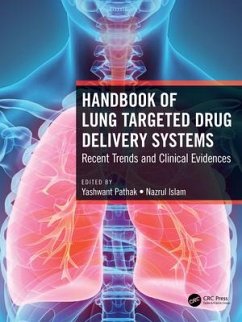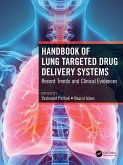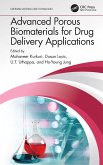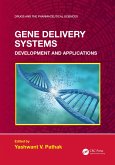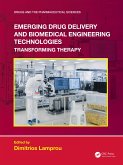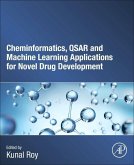Handbook of Lung Targeted Drug Delivery Systems
Recent Trends and Clinical Evidences
Herausgeber: Islam, Nazrul; Pathak, Yashwant
Handbook of Lung Targeted Drug Delivery Systems
Recent Trends and Clinical Evidences
Herausgeber: Islam, Nazrul; Pathak, Yashwant
- Broschiertes Buch
- Merkliste
- Auf die Merkliste
- Bewerten Bewerten
- Teilen
- Produkt teilen
- Produkterinnerung
- Produkterinnerung
Handbook of Lung Targeted Drug Delivery Systems: Recent Trends and Clinical Evidences covers every aspect of the drug delivery to lungs, the physiology and pharmacology of the lung, modelling for lung delivery, drug devices focused on lung treatment, regulatory requirements, and recent trends in clinical applications.
Andere Kunden interessierten sich auch für
![Handbook of Lung Targeted Drug Delivery Systems Handbook of Lung Targeted Drug Delivery Systems]() Handbook of Lung Targeted Drug Delivery Systems277,99 €
Handbook of Lung Targeted Drug Delivery Systems277,99 €![Advanced Porous Biomaterials for Drug Delivery Applications Advanced Porous Biomaterials for Drug Delivery Applications]() Advanced Porous Biomaterials for Drug Delivery Applications175,99 €
Advanced Porous Biomaterials for Drug Delivery Applications175,99 €![Gene Delivery Systems Gene Delivery Systems]() Gene Delivery Systems162,99 €
Gene Delivery Systems162,99 €![Emerging Drug Delivery and Biomedical Engineering Technologies Emerging Drug Delivery and Biomedical Engineering Technologies]() Emerging Drug Delivery and Biomedical Engineering Technologies133,99 €
Emerging Drug Delivery and Biomedical Engineering Technologies133,99 €![Engineered Nanoparticles as Drug Delivery Systems Engineered Nanoparticles as Drug Delivery Systems]() Nahid Rehman (Motilal Nehru National Inst. Of Tech., Allahabad, IndEngineered Nanoparticles as Drug Delivery Systems109,99 €
Nahid Rehman (Motilal Nehru National Inst. Of Tech., Allahabad, IndEngineered Nanoparticles as Drug Delivery Systems109,99 €![Cheminformatics, QSAR and Machine Learning Applications for Novel Drug Development Cheminformatics, QSAR and Machine Learning Applications for Novel Drug Development]() Cheminformatics, QSAR and Machine Learning Applications for Novel Drug Development187,99 €
Cheminformatics, QSAR and Machine Learning Applications for Novel Drug Development187,99 €![Drug Development for Cancer and Diabetes Drug Development for Cancer and Diabetes]() Drug Development for Cancer and Diabetes101,99 €
Drug Development for Cancer and Diabetes101,99 €-
-
-
Handbook of Lung Targeted Drug Delivery Systems: Recent Trends and Clinical Evidences covers every aspect of the drug delivery to lungs, the physiology and pharmacology of the lung, modelling for lung delivery, drug devices focused on lung treatment, regulatory requirements, and recent trends in clinical applications.
Produktdetails
- Produktdetails
- Verlag: Taylor & Francis Ltd
- Seitenzahl: 670
- Erscheinungstermin: 29. Januar 2024
- Englisch
- Abmessung: 208mm x 279mm x 40mm
- Gewicht: 1606g
- ISBN-13: 9780367495527
- ISBN-10: 036749552X
- Artikelnr.: 69790005
- Verlag: Taylor & Francis Ltd
- Seitenzahl: 670
- Erscheinungstermin: 29. Januar 2024
- Englisch
- Abmessung: 208mm x 279mm x 40mm
- Gewicht: 1606g
- ISBN-13: 9780367495527
- ISBN-10: 036749552X
- Artikelnr.: 69790005
Dr Yashwant Pathak completed a PhD in Pharmaceutical Technology at Nagpur University, India and EMBA & MS in Conflict Management from Sullivan University. He is Professor and Associate Dean for Faculty Affairs at College of Pharmacy, University of South Florida. Tampa, Florida. With extensive experience in academia as well as industry, he has more than 100 publications and 2 patent and 2 patent application, 20 edited books published, including 7 books in Nanotechnology and 6 in Nutraceuticals and drug delivery systems. Dr Yashwant Pathak is also a Professor of Global health with College of Public health at USF, and recently his student completed PhD in Global health on Homeopathy medicine and its efficacy, a survey of 1274 patients in Pune in India. Dr. Nazrul Islam completed his PhD at Monash University (Australia), focusing on the development of dry powder inhaler (DPI) formulation for deep lung delivery of drugs. He worked at Mayne Pharma (Australia) as a formulation scientist. Currently, he is working in the Pharmacy Discipline at the Faculty of Health, Queensland University of Technology (QUT), Australia. As a senior lecturer, he is engaged in teaching and research in drug delivery. Dr. Islam has made key contributions to understanding the mechanism of micronized drug dispersion from dry powder agglomerates, which stipulate the formulation strategies to increase drug delivery efficiency from the formulations. He has published more than 50 research articles and 2 book chapters. He is a member of the American Association for the Pharmaceutical Scientist (AAPS) and the Australian Pharmaceutical Science Association (APSA). His key research areas are pulmonary drug delivery, nanotechnology, biodegradable polymer nanoparticles, DPI formulation, aerosol delivery, drug formulation and delivery, and stability studies of drug and drug products.
Contents
Editors
................................................................................................................
xi
List of Contributors
.............................................................................................
xiii
Foreword.............................................................................................................
xix
Preface.................................................................................................................
xxi
1 Introduction to Lung Physiology from a Drug Delivery
Perspective.................................................................................1
Aparoop Das, Manash Pratim Pathak, Pompy Patowary, and Sanghita Das
2 Introduction to Pharmacology of the Lung from a
Drug Delivery
Perspective......................................................................................................................................................13
Caline McCarthy and Charles Preuss
3 Mechanism and Ways of Pulmonary Drug
Administration
.........................................................................................................................................................................29
Ahmed S. Fahad, Sai H.S. Boddu, and Jerry Nesamony
4 Transepithelial Route of Drug Delivery through the
Pulmonary
System...................................................................................................................................................................41
Sakshi Kumar and Swati Gupta
5 Understanding the Pharmacokinetics and
Pharmacodynamics of Lung and Lung Drug Delivery
......................................................................................................53
Seth Kwabena Amponsah
6 Chronic Lung Diseases: Treatment, Challenges, and
Solutions....................................................................................................................................................................................61
Aparoop Das, Riya Saikia, Kalyani Pathak, Urvashee Gogoi, and Surovi Saikia
7 Understanding of Lung Diseases with a Focus on
Applications of Nano-particulate Drug Delivery
Systems..................................................................................................73
Shraddha Khairnar, Mudassir Ansari, Ujwala Shinde, Agnivesh Shrivastava,
and Kavita Singh
8 Model for Pharmaceutical Aerosol Transport through
Stenosis
Airway........................................................................................................................................................................91
Puchanee Larpruenrudee, Mohammad S. Islam, Gunther Paul, Akshoy R. Paul, Y.
T. Gu, and
Suvash C. Saha
9 Design of Efficient Dry Powder
Inhalers....................
...............................................................................................................................................................129
Anurag Tiwari, Akshoy R. Paul, Anuj Jain, and Suvash C. Saha
10 In Vivo Animal Models for Lung Targeted Drug
Delivery
Systems....................................................................................................................................................................155
Khushali Vashi, Jasmin Patel, and Yashwant Pathak
11 Advances in In Silico Study of Generic Orally Inhaled
Drug
Products........................................................................................................................................................................161
Hao Miao, Renjie Li, Xudong Zhou, Jiaqi Yu, Fen Huang, Haoqin Yang, and
Zhenbo Tong
12 Effect of Aerosol Devices and Administration
Techniques on Drug Delivery in a Simulated Spontaneously Breathing
Pediatric Tracheostomy Model................171
Amelia Alberts and Charles Preuss
13 Pulmonary Drug Delivery: The Role of Polymeric
Nanoparticles..........................................................................................................................................................................181
Ofosua Adi-Dako, Doris Kumadoh, Esther Eshun Oppong, Christina Osei Asare,
and Mary Ann Archer
14 Polymeric Nanoparticle-Based Drug-Gene Delivery
for Lung Cancer
....................................................................................................................................................................193
Keshav Moharir, Vinita Kale, Abhay Ittadwar, and Manash K. Paul
15 Inhalable Polymeric Nano-particulate Powders for
Respiratory Delivery
.............................................................................................................................................................209
Anita Patel and Jayvadan Patel
vii
16 Recent Trends in Applications of Nano-Drug Delivery
Systems....................................................................................................................................................................................225
Doris Kumadoh, Ofosua Adi-Dako, Yaa Asantewaa Osei, and Mary Ann Archer
17 Nanocarrier Systems for Lung Drug
Delivery....................
...............................................................................................................................................................239
Sai HS. Boddu and Jerry Nesamony
18 Nanomedicine for the Management of Pulmonary
Disorders.................................................................................................................................................................................257
Pompy Patowary, Manash Pratim Pathak, Pronobesh Chattopadhyay, and Kamaruz
Zaman
19 Recent Approaches in Dendrimer-Based Pulmonary
Drug
Delivery.........................................................................................................................................................................273
Rajiv Dahiya and Sunita Dahiya
20 Hybrid Lipid/Polymer Nanoparticles for Pulmonary
Delivery of siRNA: Development and Fate Upon In Vitro Deposition on the
Human Epithelial Airway
Barrier
....................................................................................................................................................................................287
Samyak Nag, Shivani Baliyan, and Swati Gupta
21 Solid Lipid Nanoparticle-Based Drug Delivery for
Lung Cancer
..........................................................................................................................................................................303
Deepa U. Warrier, Harita R. Desai, Kavita H. Singh, and Ujwala A. Shinde
22 Lipid-Based Pulmonary Delivery System: A Review
and Future Considerations of Formulation Strategies and Limitations
........................................................................325
Komal Parmar and Jayvadan Patel
23 Respirable Controlled Release Polymeric Colloidal
Nanoparticles..........................................................................................................................................................................337
Nazrul Islam and Abdur Rashid
24 Lung Clearance Kinetics of Liposomes and Solid Lipid
Nanoparticles..........................................................................................................................................................................353
Soumalya Chakraborty, Sudipta Roy, Akash Dey, Sanjoy Kumar Das, Dhananjoy
Saha, Subhabrata Ray,
and Bhaskar Mazumder
25 Solid Lipid Nanoparticles for Sustained Pulmonary
Delivery of Herbal Drugs for Lung Delivery: Preparation, Characterization,
and In Vivo Evaluation ..................361
Nayanmoni Boruah, Himangshu Sharma, and Hemanta Kumar Sharma
26 Improved Solid Lipid Nano-formulations for
Pulmonary Delivery of Paclitaxel for Lung Cancer Therapy
.........................................................................................387
Samson A. Adeyemi, Pradeep Kumar, Viness Pillay, and Yahya E. Choonara
27 Anti-angiogenic Therapy for Lung Cancer: Focus on
Bioassay Development in a Quest for Anti-VEGF
Drugs................................................................................................409
Urvashi Bhati, Colin J. Barrow, Jagat R. Kanwar, Arnab Kapat, Venkata
Ramana, and Rupinder K. Kanwar
28 Emerging Applications of Nanoparticles for Lung
Cancer Diagnosis and Therapy
...........................................................................................................................................423
Raja Reddy, Bommareddy, Sheshanka Kesani, and Yashwant Pathak
29 Metallic Nanoparticles: Technology Overview and
Drug Delivery Applications in Lung
Cancer.....................................................................................................................433
Komal Parmar and Jayvadan Patel
30 Modeling of Pharmaceutical Aerosol Transport in the
Targeted Region of Human Lung Airways Due to External Magnetic Field
...............................................................443
Anusmriti Ghosh, Mohammad S. Islam, Mohammad Rahimi-Gorji, Raj Das, and
Suvash C. Saha
31 Phytochemicals and Biogenic Metallic Nanoparticles as
Anti-cancer Agents in Lung Cancer
...................................................................................................................................459
Nana Ama Mireku-Gyimah, Rex Frimpong Anane, and Louis Hamenu
32 Pulmonary Applications and Toxicity of Engineered
Metallic Nanoparticles
..........................................................................................................................................................471
Deepti Kaushalkumar Jani
33 Anti-cancer Activity of Eco-friendly Gold
Nanoparticles against Lung and Liver Cancer
Cells........................................................................................................483
Jayvadan Patel and Anita Patel
viii Contents
34 Sub-chronic Inhalational Toxicity Studies for Gold
Nanoparticles..........................................................................................................................................................................497
Srijan Mishra and Jigna Shah
35 Single-Use Dry Powder Inhalers for Pulmonary Drug
Delivery...................................................................................................................................................................................503
Somchai Sawatdee and Teerapol Srichana
36 Lung Delivery of Nicotine for Smoking
Cessation....................
.............................................................................................................................................................513
Hui Wang and Nazrul Islam
37 Formulation and Characterization of Dry Powder
Inhalers for Pulmonary Drug Delivery
..............................................................................................................................527
Himangshu Sarma, Nayanmoni Boruah, and Hemanta Kumar Sharma
38 Devices for Dry Powder Drug Delivery to the
Lung....................
....................................................................................................................................................................539
Vimal Patel, Jigar Shah, Hiral Shah, and Jayvadan Patel
39 Numerical Modeling of Agglomeration and
De-agglomeration in Dry Powder Inhalers
........................................................................................................................549
Tan Suwandecha and Teerapol Srichana
40 Oronasal and Tracheostomy Delivery of Soft Mist and
Pressurized Metered-Dose Inhalers with Valved Holding
Chamber..............................................................................557
Dasharath M. Patel, Unnati D. Chanpura, and Veer J. Patel
41 Modeling for Biopharmaceutical Performance in Lung
Drug Discovery
......................................................................................................................................................................575
Amy Le, Kianna Samuel, Truong Tran, and Yashwant Pathak
42 Regulatory Consideration for Approval of Generic
Inhalation Drug Products in the US, EU, Brazil, China, and India
..............................................................................579
Urvashi K. Parmar and Jayvadan Patel
43 Regulatory Perspectives and Concerns Related to
Nanoparticle-Based Lung Delivery
.....................................................................................................................................591
Johirul Islam, Hemanga Hazarika, Probin Kr Roy, Pompy Patowary Pronobesh
Chattopadhyay,
Yashwant V. Pathak, and Kamaruz Zaman
44 Clinical Controversies of Pediatric Aerosol
Therapy...................................................................................................................................................................................611
Jeffrey Cruz and Charles Preuss
45 Drug Delivery Using Aerosols: Challenges and
Advances in Neonatal Pediatric Subgroup
........................................................................................................................623
Surovi Saikia, Aparoop Das, and Yashwant Pathak
46 Safety and Toxicological Concerns Related to
Nanoparticle-Based Lung Delivery
.....................................................................................................................................631
Humera Memon, Vandit Shah, Tejal Mehta, and Jigna Shah
47 Nanoparticle-Based Lung Drug Delivery: A Clinical Perspective
..................................................................................643
Vandit Shah and Jigna Shah
48 European Perspective on Orally Inhaled Products: In
Vitro Requirements for a Biowaiver
..................................................................................................................................653
Sunita Chaudhary, Dhaval Patel, Dasharath M. Patel, and Jayvadan K. Patel
Index....................................................................................................................................................................................
661
Editors
................................................................................................................
xi
List of Contributors
.............................................................................................
xiii
Foreword.............................................................................................................
xix
Preface.................................................................................................................
xxi
1 Introduction to Lung Physiology from a Drug Delivery
Perspective.................................................................................1
Aparoop Das, Manash Pratim Pathak, Pompy Patowary, and Sanghita Das
2 Introduction to Pharmacology of the Lung from a
Drug Delivery
Perspective......................................................................................................................................................13
Caline McCarthy and Charles Preuss
3 Mechanism and Ways of Pulmonary Drug
Administration
.........................................................................................................................................................................29
Ahmed S. Fahad, Sai H.S. Boddu, and Jerry Nesamony
4 Transepithelial Route of Drug Delivery through the
Pulmonary
System...................................................................................................................................................................41
Sakshi Kumar and Swati Gupta
5 Understanding the Pharmacokinetics and
Pharmacodynamics of Lung and Lung Drug Delivery
......................................................................................................53
Seth Kwabena Amponsah
6 Chronic Lung Diseases: Treatment, Challenges, and
Solutions....................................................................................................................................................................................61
Aparoop Das, Riya Saikia, Kalyani Pathak, Urvashee Gogoi, and Surovi Saikia
7 Understanding of Lung Diseases with a Focus on
Applications of Nano-particulate Drug Delivery
Systems..................................................................................................73
Shraddha Khairnar, Mudassir Ansari, Ujwala Shinde, Agnivesh Shrivastava,
and Kavita Singh
8 Model for Pharmaceutical Aerosol Transport through
Stenosis
Airway........................................................................................................................................................................91
Puchanee Larpruenrudee, Mohammad S. Islam, Gunther Paul, Akshoy R. Paul, Y.
T. Gu, and
Suvash C. Saha
9 Design of Efficient Dry Powder
Inhalers....................
...............................................................................................................................................................129
Anurag Tiwari, Akshoy R. Paul, Anuj Jain, and Suvash C. Saha
10 In Vivo Animal Models for Lung Targeted Drug
Delivery
Systems....................................................................................................................................................................155
Khushali Vashi, Jasmin Patel, and Yashwant Pathak
11 Advances in In Silico Study of Generic Orally Inhaled
Drug
Products........................................................................................................................................................................161
Hao Miao, Renjie Li, Xudong Zhou, Jiaqi Yu, Fen Huang, Haoqin Yang, and
Zhenbo Tong
12 Effect of Aerosol Devices and Administration
Techniques on Drug Delivery in a Simulated Spontaneously Breathing
Pediatric Tracheostomy Model................171
Amelia Alberts and Charles Preuss
13 Pulmonary Drug Delivery: The Role of Polymeric
Nanoparticles..........................................................................................................................................................................181
Ofosua Adi-Dako, Doris Kumadoh, Esther Eshun Oppong, Christina Osei Asare,
and Mary Ann Archer
14 Polymeric Nanoparticle-Based Drug-Gene Delivery
for Lung Cancer
....................................................................................................................................................................193
Keshav Moharir, Vinita Kale, Abhay Ittadwar, and Manash K. Paul
15 Inhalable Polymeric Nano-particulate Powders for
Respiratory Delivery
.............................................................................................................................................................209
Anita Patel and Jayvadan Patel
vii
16 Recent Trends in Applications of Nano-Drug Delivery
Systems....................................................................................................................................................................................225
Doris Kumadoh, Ofosua Adi-Dako, Yaa Asantewaa Osei, and Mary Ann Archer
17 Nanocarrier Systems for Lung Drug
Delivery....................
...............................................................................................................................................................239
Sai HS. Boddu and Jerry Nesamony
18 Nanomedicine for the Management of Pulmonary
Disorders.................................................................................................................................................................................257
Pompy Patowary, Manash Pratim Pathak, Pronobesh Chattopadhyay, and Kamaruz
Zaman
19 Recent Approaches in Dendrimer-Based Pulmonary
Drug
Delivery.........................................................................................................................................................................273
Rajiv Dahiya and Sunita Dahiya
20 Hybrid Lipid/Polymer Nanoparticles for Pulmonary
Delivery of siRNA: Development and Fate Upon In Vitro Deposition on the
Human Epithelial Airway
Barrier
....................................................................................................................................................................................287
Samyak Nag, Shivani Baliyan, and Swati Gupta
21 Solid Lipid Nanoparticle-Based Drug Delivery for
Lung Cancer
..........................................................................................................................................................................303
Deepa U. Warrier, Harita R. Desai, Kavita H. Singh, and Ujwala A. Shinde
22 Lipid-Based Pulmonary Delivery System: A Review
and Future Considerations of Formulation Strategies and Limitations
........................................................................325
Komal Parmar and Jayvadan Patel
23 Respirable Controlled Release Polymeric Colloidal
Nanoparticles..........................................................................................................................................................................337
Nazrul Islam and Abdur Rashid
24 Lung Clearance Kinetics of Liposomes and Solid Lipid
Nanoparticles..........................................................................................................................................................................353
Soumalya Chakraborty, Sudipta Roy, Akash Dey, Sanjoy Kumar Das, Dhananjoy
Saha, Subhabrata Ray,
and Bhaskar Mazumder
25 Solid Lipid Nanoparticles for Sustained Pulmonary
Delivery of Herbal Drugs for Lung Delivery: Preparation, Characterization,
and In Vivo Evaluation ..................361
Nayanmoni Boruah, Himangshu Sharma, and Hemanta Kumar Sharma
26 Improved Solid Lipid Nano-formulations for
Pulmonary Delivery of Paclitaxel for Lung Cancer Therapy
.........................................................................................387
Samson A. Adeyemi, Pradeep Kumar, Viness Pillay, and Yahya E. Choonara
27 Anti-angiogenic Therapy for Lung Cancer: Focus on
Bioassay Development in a Quest for Anti-VEGF
Drugs................................................................................................409
Urvashi Bhati, Colin J. Barrow, Jagat R. Kanwar, Arnab Kapat, Venkata
Ramana, and Rupinder K. Kanwar
28 Emerging Applications of Nanoparticles for Lung
Cancer Diagnosis and Therapy
...........................................................................................................................................423
Raja Reddy, Bommareddy, Sheshanka Kesani, and Yashwant Pathak
29 Metallic Nanoparticles: Technology Overview and
Drug Delivery Applications in Lung
Cancer.....................................................................................................................433
Komal Parmar and Jayvadan Patel
30 Modeling of Pharmaceutical Aerosol Transport in the
Targeted Region of Human Lung Airways Due to External Magnetic Field
...............................................................443
Anusmriti Ghosh, Mohammad S. Islam, Mohammad Rahimi-Gorji, Raj Das, and
Suvash C. Saha
31 Phytochemicals and Biogenic Metallic Nanoparticles as
Anti-cancer Agents in Lung Cancer
...................................................................................................................................459
Nana Ama Mireku-Gyimah, Rex Frimpong Anane, and Louis Hamenu
32 Pulmonary Applications and Toxicity of Engineered
Metallic Nanoparticles
..........................................................................................................................................................471
Deepti Kaushalkumar Jani
33 Anti-cancer Activity of Eco-friendly Gold
Nanoparticles against Lung and Liver Cancer
Cells........................................................................................................483
Jayvadan Patel and Anita Patel
viii Contents
34 Sub-chronic Inhalational Toxicity Studies for Gold
Nanoparticles..........................................................................................................................................................................497
Srijan Mishra and Jigna Shah
35 Single-Use Dry Powder Inhalers for Pulmonary Drug
Delivery...................................................................................................................................................................................503
Somchai Sawatdee and Teerapol Srichana
36 Lung Delivery of Nicotine for Smoking
Cessation....................
.............................................................................................................................................................513
Hui Wang and Nazrul Islam
37 Formulation and Characterization of Dry Powder
Inhalers for Pulmonary Drug Delivery
..............................................................................................................................527
Himangshu Sarma, Nayanmoni Boruah, and Hemanta Kumar Sharma
38 Devices for Dry Powder Drug Delivery to the
Lung....................
....................................................................................................................................................................539
Vimal Patel, Jigar Shah, Hiral Shah, and Jayvadan Patel
39 Numerical Modeling of Agglomeration and
De-agglomeration in Dry Powder Inhalers
........................................................................................................................549
Tan Suwandecha and Teerapol Srichana
40 Oronasal and Tracheostomy Delivery of Soft Mist and
Pressurized Metered-Dose Inhalers with Valved Holding
Chamber..............................................................................557
Dasharath M. Patel, Unnati D. Chanpura, and Veer J. Patel
41 Modeling for Biopharmaceutical Performance in Lung
Drug Discovery
......................................................................................................................................................................575
Amy Le, Kianna Samuel, Truong Tran, and Yashwant Pathak
42 Regulatory Consideration for Approval of Generic
Inhalation Drug Products in the US, EU, Brazil, China, and India
..............................................................................579
Urvashi K. Parmar and Jayvadan Patel
43 Regulatory Perspectives and Concerns Related to
Nanoparticle-Based Lung Delivery
.....................................................................................................................................591
Johirul Islam, Hemanga Hazarika, Probin Kr Roy, Pompy Patowary Pronobesh
Chattopadhyay,
Yashwant V. Pathak, and Kamaruz Zaman
44 Clinical Controversies of Pediatric Aerosol
Therapy...................................................................................................................................................................................611
Jeffrey Cruz and Charles Preuss
45 Drug Delivery Using Aerosols: Challenges and
Advances in Neonatal Pediatric Subgroup
........................................................................................................................623
Surovi Saikia, Aparoop Das, and Yashwant Pathak
46 Safety and Toxicological Concerns Related to
Nanoparticle-Based Lung Delivery
.....................................................................................................................................631
Humera Memon, Vandit Shah, Tejal Mehta, and Jigna Shah
47 Nanoparticle-Based Lung Drug Delivery: A Clinical Perspective
..................................................................................643
Vandit Shah and Jigna Shah
48 European Perspective on Orally Inhaled Products: In
Vitro Requirements for a Biowaiver
..................................................................................................................................653
Sunita Chaudhary, Dhaval Patel, Dasharath M. Patel, and Jayvadan K. Patel
Index....................................................................................................................................................................................
661
Contents
Editors
................................................................................................................
xi
List of Contributors
.............................................................................................
xiii
Foreword.............................................................................................................
xix
Preface.................................................................................................................
xxi
1 Introduction to Lung Physiology from a Drug Delivery
Perspective.................................................................................1
Aparoop Das, Manash Pratim Pathak, Pompy Patowary, and Sanghita Das
2 Introduction to Pharmacology of the Lung from a
Drug Delivery
Perspective......................................................................................................................................................13
Caline McCarthy and Charles Preuss
3 Mechanism and Ways of Pulmonary Drug
Administration
.........................................................................................................................................................................29
Ahmed S. Fahad, Sai H.S. Boddu, and Jerry Nesamony
4 Transepithelial Route of Drug Delivery through the
Pulmonary
System...................................................................................................................................................................41
Sakshi Kumar and Swati Gupta
5 Understanding the Pharmacokinetics and
Pharmacodynamics of Lung and Lung Drug Delivery
......................................................................................................53
Seth Kwabena Amponsah
6 Chronic Lung Diseases: Treatment, Challenges, and
Solutions....................................................................................................................................................................................61
Aparoop Das, Riya Saikia, Kalyani Pathak, Urvashee Gogoi, and Surovi Saikia
7 Understanding of Lung Diseases with a Focus on
Applications of Nano-particulate Drug Delivery
Systems..................................................................................................73
Shraddha Khairnar, Mudassir Ansari, Ujwala Shinde, Agnivesh Shrivastava,
and Kavita Singh
8 Model for Pharmaceutical Aerosol Transport through
Stenosis
Airway........................................................................................................................................................................91
Puchanee Larpruenrudee, Mohammad S. Islam, Gunther Paul, Akshoy R. Paul, Y.
T. Gu, and
Suvash C. Saha
9 Design of Efficient Dry Powder
Inhalers....................
...............................................................................................................................................................129
Anurag Tiwari, Akshoy R. Paul, Anuj Jain, and Suvash C. Saha
10 In Vivo Animal Models for Lung Targeted Drug
Delivery
Systems....................................................................................................................................................................155
Khushali Vashi, Jasmin Patel, and Yashwant Pathak
11 Advances in In Silico Study of Generic Orally Inhaled
Drug
Products........................................................................................................................................................................161
Hao Miao, Renjie Li, Xudong Zhou, Jiaqi Yu, Fen Huang, Haoqin Yang, and
Zhenbo Tong
12 Effect of Aerosol Devices and Administration
Techniques on Drug Delivery in a Simulated Spontaneously Breathing
Pediatric Tracheostomy Model................171
Amelia Alberts and Charles Preuss
13 Pulmonary Drug Delivery: The Role of Polymeric
Nanoparticles..........................................................................................................................................................................181
Ofosua Adi-Dako, Doris Kumadoh, Esther Eshun Oppong, Christina Osei Asare,
and Mary Ann Archer
14 Polymeric Nanoparticle-Based Drug-Gene Delivery
for Lung Cancer
....................................................................................................................................................................193
Keshav Moharir, Vinita Kale, Abhay Ittadwar, and Manash K. Paul
15 Inhalable Polymeric Nano-particulate Powders for
Respiratory Delivery
.............................................................................................................................................................209
Anita Patel and Jayvadan Patel
vii
16 Recent Trends in Applications of Nano-Drug Delivery
Systems....................................................................................................................................................................................225
Doris Kumadoh, Ofosua Adi-Dako, Yaa Asantewaa Osei, and Mary Ann Archer
17 Nanocarrier Systems for Lung Drug
Delivery....................
...............................................................................................................................................................239
Sai HS. Boddu and Jerry Nesamony
18 Nanomedicine for the Management of Pulmonary
Disorders.................................................................................................................................................................................257
Pompy Patowary, Manash Pratim Pathak, Pronobesh Chattopadhyay, and Kamaruz
Zaman
19 Recent Approaches in Dendrimer-Based Pulmonary
Drug
Delivery.........................................................................................................................................................................273
Rajiv Dahiya and Sunita Dahiya
20 Hybrid Lipid/Polymer Nanoparticles for Pulmonary
Delivery of siRNA: Development and Fate Upon In Vitro Deposition on the
Human Epithelial Airway
Barrier
....................................................................................................................................................................................287
Samyak Nag, Shivani Baliyan, and Swati Gupta
21 Solid Lipid Nanoparticle-Based Drug Delivery for
Lung Cancer
..........................................................................................................................................................................303
Deepa U. Warrier, Harita R. Desai, Kavita H. Singh, and Ujwala A. Shinde
22 Lipid-Based Pulmonary Delivery System: A Review
and Future Considerations of Formulation Strategies and Limitations
........................................................................325
Komal Parmar and Jayvadan Patel
23 Respirable Controlled Release Polymeric Colloidal
Nanoparticles..........................................................................................................................................................................337
Nazrul Islam and Abdur Rashid
24 Lung Clearance Kinetics of Liposomes and Solid Lipid
Nanoparticles..........................................................................................................................................................................353
Soumalya Chakraborty, Sudipta Roy, Akash Dey, Sanjoy Kumar Das, Dhananjoy
Saha, Subhabrata Ray,
and Bhaskar Mazumder
25 Solid Lipid Nanoparticles for Sustained Pulmonary
Delivery of Herbal Drugs for Lung Delivery: Preparation, Characterization,
and In Vivo Evaluation ..................361
Nayanmoni Boruah, Himangshu Sharma, and Hemanta Kumar Sharma
26 Improved Solid Lipid Nano-formulations for
Pulmonary Delivery of Paclitaxel for Lung Cancer Therapy
.........................................................................................387
Samson A. Adeyemi, Pradeep Kumar, Viness Pillay, and Yahya E. Choonara
27 Anti-angiogenic Therapy for Lung Cancer: Focus on
Bioassay Development in a Quest for Anti-VEGF
Drugs................................................................................................409
Urvashi Bhati, Colin J. Barrow, Jagat R. Kanwar, Arnab Kapat, Venkata
Ramana, and Rupinder K. Kanwar
28 Emerging Applications of Nanoparticles for Lung
Cancer Diagnosis and Therapy
...........................................................................................................................................423
Raja Reddy, Bommareddy, Sheshanka Kesani, and Yashwant Pathak
29 Metallic Nanoparticles: Technology Overview and
Drug Delivery Applications in Lung
Cancer.....................................................................................................................433
Komal Parmar and Jayvadan Patel
30 Modeling of Pharmaceutical Aerosol Transport in the
Targeted Region of Human Lung Airways Due to External Magnetic Field
...............................................................443
Anusmriti Ghosh, Mohammad S. Islam, Mohammad Rahimi-Gorji, Raj Das, and
Suvash C. Saha
31 Phytochemicals and Biogenic Metallic Nanoparticles as
Anti-cancer Agents in Lung Cancer
...................................................................................................................................459
Nana Ama Mireku-Gyimah, Rex Frimpong Anane, and Louis Hamenu
32 Pulmonary Applications and Toxicity of Engineered
Metallic Nanoparticles
..........................................................................................................................................................471
Deepti Kaushalkumar Jani
33 Anti-cancer Activity of Eco-friendly Gold
Nanoparticles against Lung and Liver Cancer
Cells........................................................................................................483
Jayvadan Patel and Anita Patel
viii Contents
34 Sub-chronic Inhalational Toxicity Studies for Gold
Nanoparticles..........................................................................................................................................................................497
Srijan Mishra and Jigna Shah
35 Single-Use Dry Powder Inhalers for Pulmonary Drug
Delivery...................................................................................................................................................................................503
Somchai Sawatdee and Teerapol Srichana
36 Lung Delivery of Nicotine for Smoking
Cessation....................
.............................................................................................................................................................513
Hui Wang and Nazrul Islam
37 Formulation and Characterization of Dry Powder
Inhalers for Pulmonary Drug Delivery
..............................................................................................................................527
Himangshu Sarma, Nayanmoni Boruah, and Hemanta Kumar Sharma
38 Devices for Dry Powder Drug Delivery to the
Lung....................
....................................................................................................................................................................539
Vimal Patel, Jigar Shah, Hiral Shah, and Jayvadan Patel
39 Numerical Modeling of Agglomeration and
De-agglomeration in Dry Powder Inhalers
........................................................................................................................549
Tan Suwandecha and Teerapol Srichana
40 Oronasal and Tracheostomy Delivery of Soft Mist and
Pressurized Metered-Dose Inhalers with Valved Holding
Chamber..............................................................................557
Dasharath M. Patel, Unnati D. Chanpura, and Veer J. Patel
41 Modeling for Biopharmaceutical Performance in Lung
Drug Discovery
......................................................................................................................................................................575
Amy Le, Kianna Samuel, Truong Tran, and Yashwant Pathak
42 Regulatory Consideration for Approval of Generic
Inhalation Drug Products in the US, EU, Brazil, China, and India
..............................................................................579
Urvashi K. Parmar and Jayvadan Patel
43 Regulatory Perspectives and Concerns Related to
Nanoparticle-Based Lung Delivery
.....................................................................................................................................591
Johirul Islam, Hemanga Hazarika, Probin Kr Roy, Pompy Patowary Pronobesh
Chattopadhyay,
Yashwant V. Pathak, and Kamaruz Zaman
44 Clinical Controversies of Pediatric Aerosol
Therapy...................................................................................................................................................................................611
Jeffrey Cruz and Charles Preuss
45 Drug Delivery Using Aerosols: Challenges and
Advances in Neonatal Pediatric Subgroup
........................................................................................................................623
Surovi Saikia, Aparoop Das, and Yashwant Pathak
46 Safety and Toxicological Concerns Related to
Nanoparticle-Based Lung Delivery
.....................................................................................................................................631
Humera Memon, Vandit Shah, Tejal Mehta, and Jigna Shah
47 Nanoparticle-Based Lung Drug Delivery: A Clinical Perspective
..................................................................................643
Vandit Shah and Jigna Shah
48 European Perspective on Orally Inhaled Products: In
Vitro Requirements for a Biowaiver
..................................................................................................................................653
Sunita Chaudhary, Dhaval Patel, Dasharath M. Patel, and Jayvadan K. Patel
Index....................................................................................................................................................................................
661
Editors
................................................................................................................
xi
List of Contributors
.............................................................................................
xiii
Foreword.............................................................................................................
xix
Preface.................................................................................................................
xxi
1 Introduction to Lung Physiology from a Drug Delivery
Perspective.................................................................................1
Aparoop Das, Manash Pratim Pathak, Pompy Patowary, and Sanghita Das
2 Introduction to Pharmacology of the Lung from a
Drug Delivery
Perspective......................................................................................................................................................13
Caline McCarthy and Charles Preuss
3 Mechanism and Ways of Pulmonary Drug
Administration
.........................................................................................................................................................................29
Ahmed S. Fahad, Sai H.S. Boddu, and Jerry Nesamony
4 Transepithelial Route of Drug Delivery through the
Pulmonary
System...................................................................................................................................................................41
Sakshi Kumar and Swati Gupta
5 Understanding the Pharmacokinetics and
Pharmacodynamics of Lung and Lung Drug Delivery
......................................................................................................53
Seth Kwabena Amponsah
6 Chronic Lung Diseases: Treatment, Challenges, and
Solutions....................................................................................................................................................................................61
Aparoop Das, Riya Saikia, Kalyani Pathak, Urvashee Gogoi, and Surovi Saikia
7 Understanding of Lung Diseases with a Focus on
Applications of Nano-particulate Drug Delivery
Systems..................................................................................................73
Shraddha Khairnar, Mudassir Ansari, Ujwala Shinde, Agnivesh Shrivastava,
and Kavita Singh
8 Model for Pharmaceutical Aerosol Transport through
Stenosis
Airway........................................................................................................................................................................91
Puchanee Larpruenrudee, Mohammad S. Islam, Gunther Paul, Akshoy R. Paul, Y.
T. Gu, and
Suvash C. Saha
9 Design of Efficient Dry Powder
Inhalers....................
...............................................................................................................................................................129
Anurag Tiwari, Akshoy R. Paul, Anuj Jain, and Suvash C. Saha
10 In Vivo Animal Models for Lung Targeted Drug
Delivery
Systems....................................................................................................................................................................155
Khushali Vashi, Jasmin Patel, and Yashwant Pathak
11 Advances in In Silico Study of Generic Orally Inhaled
Drug
Products........................................................................................................................................................................161
Hao Miao, Renjie Li, Xudong Zhou, Jiaqi Yu, Fen Huang, Haoqin Yang, and
Zhenbo Tong
12 Effect of Aerosol Devices and Administration
Techniques on Drug Delivery in a Simulated Spontaneously Breathing
Pediatric Tracheostomy Model................171
Amelia Alberts and Charles Preuss
13 Pulmonary Drug Delivery: The Role of Polymeric
Nanoparticles..........................................................................................................................................................................181
Ofosua Adi-Dako, Doris Kumadoh, Esther Eshun Oppong, Christina Osei Asare,
and Mary Ann Archer
14 Polymeric Nanoparticle-Based Drug-Gene Delivery
for Lung Cancer
....................................................................................................................................................................193
Keshav Moharir, Vinita Kale, Abhay Ittadwar, and Manash K. Paul
15 Inhalable Polymeric Nano-particulate Powders for
Respiratory Delivery
.............................................................................................................................................................209
Anita Patel and Jayvadan Patel
vii
16 Recent Trends in Applications of Nano-Drug Delivery
Systems....................................................................................................................................................................................225
Doris Kumadoh, Ofosua Adi-Dako, Yaa Asantewaa Osei, and Mary Ann Archer
17 Nanocarrier Systems for Lung Drug
Delivery....................
...............................................................................................................................................................239
Sai HS. Boddu and Jerry Nesamony
18 Nanomedicine for the Management of Pulmonary
Disorders.................................................................................................................................................................................257
Pompy Patowary, Manash Pratim Pathak, Pronobesh Chattopadhyay, and Kamaruz
Zaman
19 Recent Approaches in Dendrimer-Based Pulmonary
Drug
Delivery.........................................................................................................................................................................273
Rajiv Dahiya and Sunita Dahiya
20 Hybrid Lipid/Polymer Nanoparticles for Pulmonary
Delivery of siRNA: Development and Fate Upon In Vitro Deposition on the
Human Epithelial Airway
Barrier
....................................................................................................................................................................................287
Samyak Nag, Shivani Baliyan, and Swati Gupta
21 Solid Lipid Nanoparticle-Based Drug Delivery for
Lung Cancer
..........................................................................................................................................................................303
Deepa U. Warrier, Harita R. Desai, Kavita H. Singh, and Ujwala A. Shinde
22 Lipid-Based Pulmonary Delivery System: A Review
and Future Considerations of Formulation Strategies and Limitations
........................................................................325
Komal Parmar and Jayvadan Patel
23 Respirable Controlled Release Polymeric Colloidal
Nanoparticles..........................................................................................................................................................................337
Nazrul Islam and Abdur Rashid
24 Lung Clearance Kinetics of Liposomes and Solid Lipid
Nanoparticles..........................................................................................................................................................................353
Soumalya Chakraborty, Sudipta Roy, Akash Dey, Sanjoy Kumar Das, Dhananjoy
Saha, Subhabrata Ray,
and Bhaskar Mazumder
25 Solid Lipid Nanoparticles for Sustained Pulmonary
Delivery of Herbal Drugs for Lung Delivery: Preparation, Characterization,
and In Vivo Evaluation ..................361
Nayanmoni Boruah, Himangshu Sharma, and Hemanta Kumar Sharma
26 Improved Solid Lipid Nano-formulations for
Pulmonary Delivery of Paclitaxel for Lung Cancer Therapy
.........................................................................................387
Samson A. Adeyemi, Pradeep Kumar, Viness Pillay, and Yahya E. Choonara
27 Anti-angiogenic Therapy for Lung Cancer: Focus on
Bioassay Development in a Quest for Anti-VEGF
Drugs................................................................................................409
Urvashi Bhati, Colin J. Barrow, Jagat R. Kanwar, Arnab Kapat, Venkata
Ramana, and Rupinder K. Kanwar
28 Emerging Applications of Nanoparticles for Lung
Cancer Diagnosis and Therapy
...........................................................................................................................................423
Raja Reddy, Bommareddy, Sheshanka Kesani, and Yashwant Pathak
29 Metallic Nanoparticles: Technology Overview and
Drug Delivery Applications in Lung
Cancer.....................................................................................................................433
Komal Parmar and Jayvadan Patel
30 Modeling of Pharmaceutical Aerosol Transport in the
Targeted Region of Human Lung Airways Due to External Magnetic Field
...............................................................443
Anusmriti Ghosh, Mohammad S. Islam, Mohammad Rahimi-Gorji, Raj Das, and
Suvash C. Saha
31 Phytochemicals and Biogenic Metallic Nanoparticles as
Anti-cancer Agents in Lung Cancer
...................................................................................................................................459
Nana Ama Mireku-Gyimah, Rex Frimpong Anane, and Louis Hamenu
32 Pulmonary Applications and Toxicity of Engineered
Metallic Nanoparticles
..........................................................................................................................................................471
Deepti Kaushalkumar Jani
33 Anti-cancer Activity of Eco-friendly Gold
Nanoparticles against Lung and Liver Cancer
Cells........................................................................................................483
Jayvadan Patel and Anita Patel
viii Contents
34 Sub-chronic Inhalational Toxicity Studies for Gold
Nanoparticles..........................................................................................................................................................................497
Srijan Mishra and Jigna Shah
35 Single-Use Dry Powder Inhalers for Pulmonary Drug
Delivery...................................................................................................................................................................................503
Somchai Sawatdee and Teerapol Srichana
36 Lung Delivery of Nicotine for Smoking
Cessation....................
.............................................................................................................................................................513
Hui Wang and Nazrul Islam
37 Formulation and Characterization of Dry Powder
Inhalers for Pulmonary Drug Delivery
..............................................................................................................................527
Himangshu Sarma, Nayanmoni Boruah, and Hemanta Kumar Sharma
38 Devices for Dry Powder Drug Delivery to the
Lung....................
....................................................................................................................................................................539
Vimal Patel, Jigar Shah, Hiral Shah, and Jayvadan Patel
39 Numerical Modeling of Agglomeration and
De-agglomeration in Dry Powder Inhalers
........................................................................................................................549
Tan Suwandecha and Teerapol Srichana
40 Oronasal and Tracheostomy Delivery of Soft Mist and
Pressurized Metered-Dose Inhalers with Valved Holding
Chamber..............................................................................557
Dasharath M. Patel, Unnati D. Chanpura, and Veer J. Patel
41 Modeling for Biopharmaceutical Performance in Lung
Drug Discovery
......................................................................................................................................................................575
Amy Le, Kianna Samuel, Truong Tran, and Yashwant Pathak
42 Regulatory Consideration for Approval of Generic
Inhalation Drug Products in the US, EU, Brazil, China, and India
..............................................................................579
Urvashi K. Parmar and Jayvadan Patel
43 Regulatory Perspectives and Concerns Related to
Nanoparticle-Based Lung Delivery
.....................................................................................................................................591
Johirul Islam, Hemanga Hazarika, Probin Kr Roy, Pompy Patowary Pronobesh
Chattopadhyay,
Yashwant V. Pathak, and Kamaruz Zaman
44 Clinical Controversies of Pediatric Aerosol
Therapy...................................................................................................................................................................................611
Jeffrey Cruz and Charles Preuss
45 Drug Delivery Using Aerosols: Challenges and
Advances in Neonatal Pediatric Subgroup
........................................................................................................................623
Surovi Saikia, Aparoop Das, and Yashwant Pathak
46 Safety and Toxicological Concerns Related to
Nanoparticle-Based Lung Delivery
.....................................................................................................................................631
Humera Memon, Vandit Shah, Tejal Mehta, and Jigna Shah
47 Nanoparticle-Based Lung Drug Delivery: A Clinical Perspective
..................................................................................643
Vandit Shah and Jigna Shah
48 European Perspective on Orally Inhaled Products: In
Vitro Requirements for a Biowaiver
..................................................................................................................................653
Sunita Chaudhary, Dhaval Patel, Dasharath M. Patel, and Jayvadan K. Patel
Index....................................................................................................................................................................................
661

